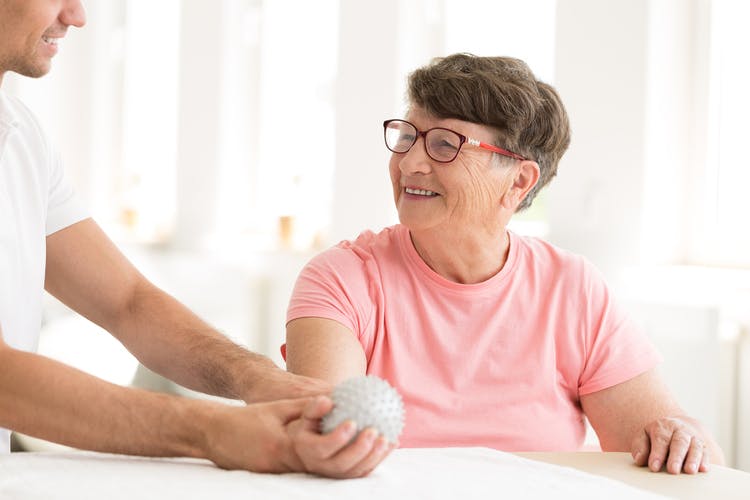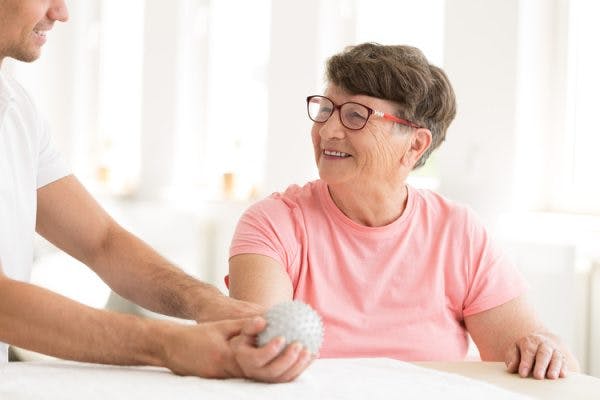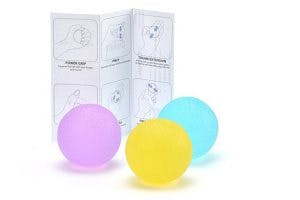Hand therapy exercises help improve strength and dexterity in the hands, which leads to improved function over time. This is how you achieve improved coordination and fine motor skills after a neurologic event like stroke or brain injury. In addition, hand therapy exercises can also help prevent conditions like arthritis from getting worse.
In this article, we will cover a comprehensive set of hand therapy exercises for strengthening and improving hand function. These can be incorporated into any home exercise program and offer a great way for you to stay on top of your rehab.
This hand therapy exercise guide contains exercises for all ability levels. We’ve also tried to organize it from the most simple to the most complex hand exercises.
Use the links below to jump to any section:
- Stretching Exercises
- Easy At-Home Hand Therapy Exercises
- Barbara’s Hand Therapy Exercises
- Strengthening Hand Therapy Ball Exercises
- Hand Therapy Putty Exercises
- Advanced Hand Therapy Exercises
Stretching Exercises for Extremely Stiff or Paralyzed Hands
Most therapeutic home exercise programs start with a warm-up, and your hands are no different. For those with paralyzed hands from a neurological injury like stroke, start with passive exercise. This means using your unaffected hand to help your affected hand complete the exercises.
Not only will this help prevent muscle stiffness after stroke (spasticity), but it will also keep your joints limber. Stretching your paralyzed muscles helps prepare them for voluntary movements. As your muscles strengthen due to connections from your brain to your hand, your well-stretched tissues won’t resist your weakest attempts at movement by your affected hand.
Never underestimate the importance of stretching and these passive exercises. For those who have even the slightest hand mobility, these hand therapy exercises prepare your joints for strengthening in the best way possible.
1. Wrist Extension and Flexion

Start with your forearm on a table for this gentle hand dexterity exercise. Let your hand hang off the side of the table with your palm down. Then, move your hand up and down, bending at your wrist. At the end of each movement, add some pressure from your other hand to extend the stretch at the limit of your range of motion as tolerated. This will lengthen your muscles.
Feeling tightness in your muscles as you try to lengthen them is okay, but it should not be painful. When you’re done, repeat with your palm facing up. Lengthening those forearm muscles and tendons with some added pressure is okay.
2. Thumb Extension and Flexion
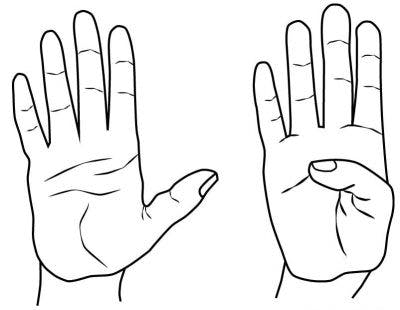
For another gentle exercise, start with your palm open, as if you were signaling the number 5. Then, practice moving your thumb over to your little finger, signaling the number 4. Continue to move your thumb back and forth between these 2 positions. As mentioned above, this can be done passively by your opposite hand moving your thumb.
3. Supination/Pronation of Your Hands
Place your hands in your lap and interlace your fingers. Then, turn your affected palm to face upward. If you straighten your elbows, you will feel this stretch in your forearm and even some in the upper arm. Hold this stretch for 20 seconds and release. Then, repeat on the other side.
4. Wrist Stretch
With your fingers still interlaced, gently bend your affected wrist backward and get a nice stretch there. Hold this stretch for 20 seconds and release. Repeat on the other side.
Individuals recovering from a stroke or brain injury may find these four exercises challenging enough. Pace yourself and target the areas your therapist had you working on or the places you find stiff. You can stop here and repeat these 4 exercises with high repetition.
Repetition and movement provide stimulation to your brain that will help it to rewire (via neuroplasticity) and improve hand function.
Those looking for additional challenges see the next hand therapy exercises.
Easy At-Home Hand Therapy Exercises
For those with some hand movement, you can use common household items as part of your home exercise program. The following tasks are simple yet therapeutic ways to strengthen your fine motor skills.
5. Stacking Coins
Grab a handful of loose change and practice stacking coins on top of each other. Any stackable items in your home will work. Coins are more challenging than checkers. Coasters, bowls, or any blocks are even easier to stack.
All this will help improve coordination and fine motor skills. Find ways to make it interesting for you to do repeatedly by including a family member.
6. Pinching Clothespins with Each Finger
Clothespins provide resistance from the spring. Practice pinching them with different fingers to make the task harder or easier. Your thumb and index finger are typically the easiest to use for this. Using your thumb against a middle, ring, or pinky finger may be very challenging. Using your thumb, index finger, and middle finger together is a functional ‘tripod grip.’
7. Playing Board Games
If you want to make things more fun and interesting, play board games like checkers or chess, which require you to practice your fine motor skills as you move your pieces. Games can be very stimulating for your brain while scanning, decision making, and sequencing tasks.
8. Putting Together a Puzzle
When putting together a puzzle, you employ a number of pinches and grips while having fun. And having fun is the key to getting more repetitions, stimulating neuroplasticity. Therefore, puzzles can double as a fun activity, improving hand and finger coordination.
9. Adapted Hand Therapy Exercises with Music
Getting back to playing instruments is a great occupational therapy hand exercise because it is a functional activity. As an alternative, if you don’t have an instrument, download a virtual piano or guitar-playing app and practice on your phone.
When you resume an activity you have done prior to your stroke, the brain remembers the movement pattern and naturally activates the normal muscle motion.
Barbara’s Physical Therapy Hand Exercises
Now it’s time to meet Barbara, our favorite occupational therapy assistant. Barbara can walk you through some helpful hand exercises. Try her expert hand therapy exercises in the video below, or by reading the instructions that follow:
10. Palm Up and Down
Place your hand palm-up on a table. Then, use your non-affected hand to flip your hand palm-down. This helps improve hand and wrist mobility as the hand moves from supination to pronation. Repeat 10 times.
11. Wrist Bend Movement
Gently bend your wrist up and down while supporting your arm on the table with the hand hanging past the edge of the table. This improves flexibility in the wrist which is needed for increased hand movement and range of motion. Repeat 10 movements.
12. Wrist Side Movement
Place your affected hand palm-down on the table and use your other hand to bend your wrist side-to-side.
13. Rolling Movement
Place a water bottle or a soup can in your affected hand with your palm side up on a table. Practice curling your fingers to grasp the bottle or can, then relax. This works on strength and range of motion. Repeat 10 times.
14. Wrist Curl
Take the same water bottle and hold it in your affected hand. Then, practice bending your wrist up and down, stabilizing your elbow on the table. This will feel like a bicep curl but for your wrist. This is an excellent strength-building exercise for your forearm.
15. Grip and Release
Take a pen and place it on a table. Practice gripping the pen with your affected hand and move it across the table. Release and repeat by bringing the pen back to the other side of the table.
16. Pen Spin
Take the same pen and practice spinning it with your thumb and index finger. This helps isolate finger movements for fine motor skills.
17. Coin Drop
Place 8 coins neatly in a row in your hand. Then, practice placing them down one at a time, using your thumb and index finger while keeping the other coins in your hand with your other fingers.
18. Finger Curl
Practice touching your thumb to each of your fingertips, starting with your index finger until you reach your little finger. Open your hand wide between each touch.
See more finger exercises for home post-stroke.
Hand Strengthening Exercises with a Therapy Ball
For some affordable and effective hand strengthening exercises, grab a set of hand therapy balls, which are a popular and affordable physical therapy tool. They usually come in different thicknesses so that you can keep yourself consistently challenged.
Resistance builds strength in your hand by placing demand on your muscles, which helps grow the muscle and nerve fibers. Use a soft ball if you’d like to focus on hand coordination and dexterity and use a firm ball if you’re focusing on hand strengthening exercises.
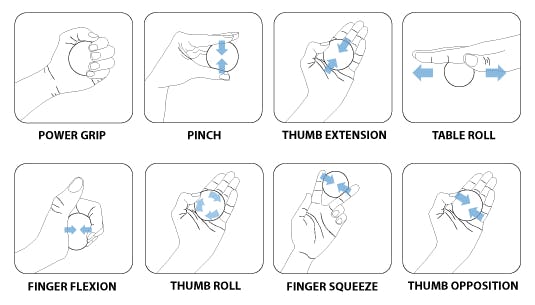
19. Power Grip
For a basic hand-strengthening exercise, squeeze a therapy ball with your fingers and thumb. Focus on pressing the pads and tips of your fingers into the ball. Pick a ball with a thickness that challenges you.
20. Pinch
Pinch the ball with fingers and thumb extended, bending only at the knuckles. Press your fingers down into the top of the ball and your thumb upward on the bottom of the ball. As with all these hand-strengthening exercises, this should make you feel challenged. If not, try to use a firmer ball.
21. Thumb Extension
Roll the ball up and down your palm by using your thumb. This requires a lot of movement from your thumb.
22. Table Roll
With the ball placed on a table, roll the ball from the tip of your fingers to your palm and back. This hand therapy exercise requires more coordination than strength.
23. Finger Flexion
Hold the ball in your palm and press your fingers into the ball. This is different from the power grip above because you’re focusing on an inward movement instead of a global gripping movement. Imagine that you’re pressing your fingers straight into your palm.
24. Thumb Roll
Use your thumb to roll the ball in a circular motion on your palm. This is less about strength building and more about improving dexterity and fine motor skills.
25. Finger Squeeze
Squeeze the ball between any two fingers. This exercise builds strength in the small muscles of your hand and provides a gentle stretch between the fingers.
26. Thumb Opposition
Roll the ball side to side on your palm using your thumb. This requires strength in your thumb as well as some coordination.
27. Finger Scissors
Squeeze the putty between two fingers. This strengthens the small muscles in the hand and provides stretch to the web space between the fingers.
Hand Therapy Putty Exercises
Putty provides an alternative to the therapy balls and tools described above. Hand therapy putty exercises with putty can be similar to the exercises described above, but the putty is more pliable and, therefore, can be graded to varying ability levels. Plus, putty allows for some creative exercises, as described below.
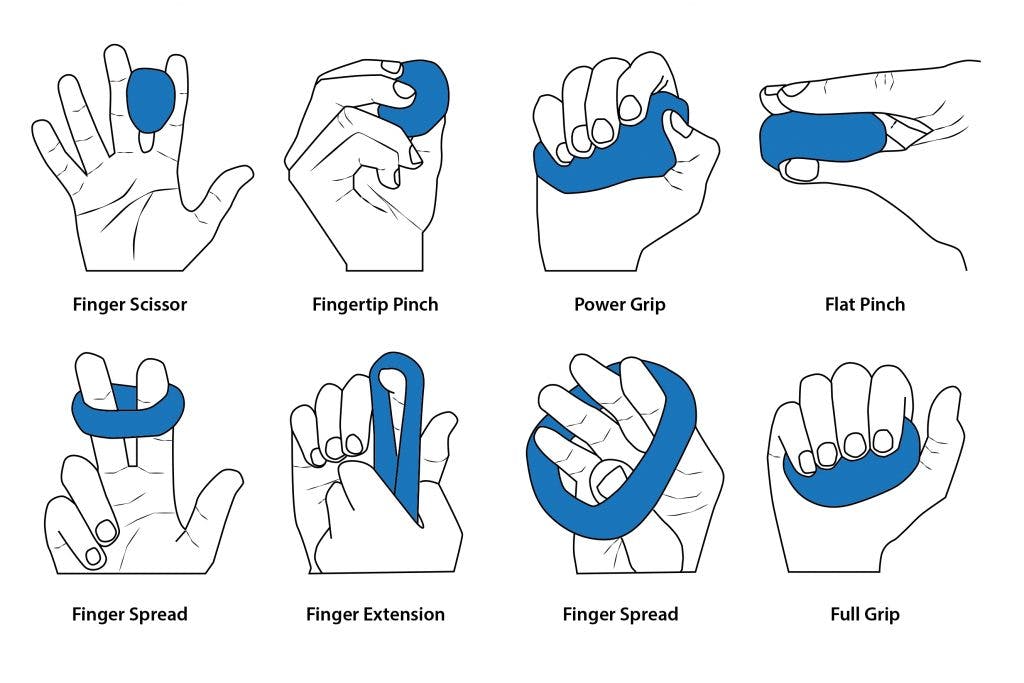
28. Fingertip Pinch
Pinch the putty using your thumb and fingertips. This also develops strength and dexterity in the fingers and reaches the small muscles in your hand.
29. Power Grip
Squeeze all your fingers into the putty. This strengthening exercise targets the muscles of your forearm, which control the hand.
30. Flat Pinch
Pinch the putty down into your thumb with straightened fingers. Only your knuckles should be flexed while the fingers remain straight. This develops your dexterity.
31. Finger Spread
Wrap the putty around two fingers and spread your fingers apart. This helps strengthen muscles inside the hand more than the forearm muscles that power the hand.
32. Finger Extension
Wrap the putty around a hooked finger and then straighten your finger using the putty as resistance.
33. Finger Spread
Wrap the putty around your hand and then spread your fingers out to stretch the putty. This targets all the muscles in your forearm that control extension of the fingers.
34. Full Grip
Squeeze down on the putty, pressing your fingers into your palm.
Advanced Hand Therapy Exercises
Once you’ve mastered the complex hand manipulation exercise, you’ll be ready to work on advanced hand therapy exercises. Once you feel ready for a challenge, add these to your home exercise program.
These last few hand therapy exercises are very advanced hand movements. Remember to start with what is fun and build from there so that you sustain your exercise program. Because it is with repetition that you will begin to make changes in your ability.
35. Palm Down Wrist Flexion Exercise (Strengthening)
Rest your forearm on a table with your hand and wrist hanging off the edge. Keep your palm facing down. Then, lift the back of your hand up. (This is the opposite of the Wrist Curl movement.)
Try it first without any weight. Then, when you’re ready for a challenge, hold a water bottle or light dumbbell in your hand while you perform this forearm strengthening exercise.
36. Rotation Exercise (Dexterity and Fine Motor Skills)
Try rotating a pen around your middle finger, using your thumb, index, and ring finger to help you manipulate the pen. Think about twirling the pen around your fingers.
37. Shifting Exercise (Dexterity and Fine Motor Skills)
Practice a sliding movement by holding the pen in a writing position (in between your thumb, index, and middle finger) and sliding the pen forward until you’re holding the end of the pen.
Then, side the pen back until you’re holding the tip once again. Think about inching your fingers along the pen.
38. In-Hand Translation Hand Exercise (Strength and Dexterity)
Gather 10 small objects (like uncooked beans) and practice picking them up with your fingers. But instead of immediately setting them down, try holding all of the objects in your palm while you continue to pick up more of them (‘in hand manipulation’). Then, once all the objects are in your hand, practice ‘translating’ them down one by one.
39. MusicGlove (Strength, Dexterity, and Fine Motor Skills)

Flint Rehab’s MusicGlove hand therapy is an interactive, music-based device that improves hand function after neurological injury like stroke or brain injury. It works by motivating patients to make hundreds of therapeutic hand movements while following along to an interactive game.
Not only is MusicGlove fun to use, but it’s also clinically proven to help stroke patients improve hand function within 2 weeks.
Click here to learn more about MusicGlove from Flint Rehab »
Looking for additional exercises – check out two of our most popular articles Hand Exercises for Stroke Patients or Finger Opposition Exercises for Stroke Recovery!

